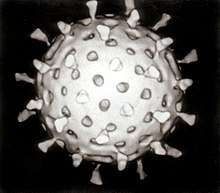Virophage
Virophages are small, double-stranded DNA viral phages that require the co-infection of another virus. The co-infecting viruses are typically giant viruses. Virophages rely on the viral replication factory of the co-infecting giant virus for their own replication. One of the characteristics of virophages is that they have a parasitic relationship with the co-infecting virus. Their dependence upon the giant virus for replication often results in the deactivation of the giant viruses. The virophage may improve the recovery and survival of the host organism.
| Lavidaviridae | |
|---|---|
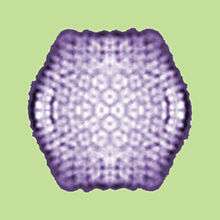 | |
| Sputnik virophage | |
| Virus classification | |
| (unranked): | Virus |
| Realm: | Varidnaviria |
| Kingdom: | Bamfordvirae |
| Phylum: | Preplasmiviricota |
| Class: | Maveriviricetes |
| Order: | Priklausovirales |
| Family: | Lavidaviridae |
| Genera and species | |
| |
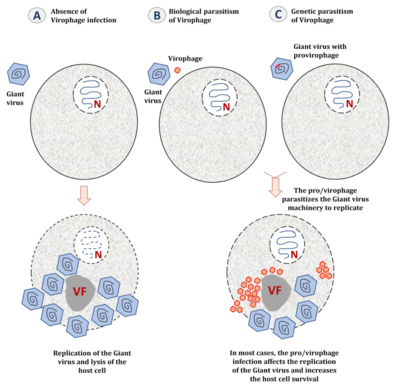
(B) When the host cell is co-infected with a giant virus and its virophage, the latter parasitizes the giant virus factory. The presence of virophages could seriously impact the infectivity of the giant virus by decreasing its replication efficiency and increasing the survival of the host cell.
(C) When the giant virus genome is parasitized by a provirophage, the latter is expressed during the giant virus replication. The virophage is produced from the giant virus factory and inhibits the giant virus replication, thus increasing the host cell survival.
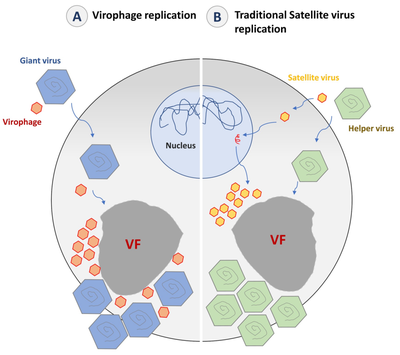
(B) The concept of satellite virus implicates that the virus initiates the expression and replication of its genome in the nucleus using the host cell machinery and then goes to the cytoplasm. In the cytoplasm, the satellite virus hijacks the morphogenesis machinery of its helper virus to produce its progeny.
Unlike satellite viruses, virophages have a parasitic effect on their co-infecting virus. Virophages have been observed to render a giant virus inactive and thereby improve the condition of the host organism.
All known virophages are grouped into the family Lavidaviridae (from "large virus dependent or associated" + -viridae).[2]
Discovery
The first virophage was discovered in a cooling tower in Paris, France in 2008. It was discovered with its co-infecting giant virus, Acanthamoeba castellanii mamavirus (ACMV). The virophage was named Sputnik and its replication relied entirely on the co-infection of ACMV and its cytoplasmic replication machinery. Sputnik was also discovered to have an inhibitory effect on ACMV and improved the survival of the host. Other characterised virophages include Sputnik 2, Sputnik 3, Zamilon and Mavirus.[3][4]
A majority of these virophages are being discovered by analyzing metagenomic data sets. In metagenomic analysis, DNA sequences are run through multiple bioinformatic algorithms which pull out certain important patterns and characteristics. In these data sets are giant viruses and virophages. They are separated by looking for sequences around 17 to 20 kbp long which have similarities to already sequenced virophages. These virophages can have linear or circular double-stranded DNA genomes.[5] Known virophages in culture have icosahedral capsid particles that measure around 40 to 80 nanometers long,[6] and virophage particles are so small that electron microscopy must be used to view them. Metagenomic sequence-based analyses have been used to predict around 57 complete and partial virophage genomes[7] and in December 2019 to identify 328 high-quality (complete or near-complete) genomes from diverse habitats including the human gut, plant rhizosphere, and terrestrial subsurface, from 27 distinct taxonomic clades.[8].
Host range and replication
Virophages need to have a co-infecting virus in order for them to replicate. The virophages do not have the necessary enzymes to replicate on their own. Virophages use the giant viral replication machinery to replicate their own genomes and continue their existence. The host range for virophages include giant viruses with double stranded DNA genomes. Virophages use the transcriptional machinery of these giant viruses for their own replication instead of the host's transcriptional machinery. For example, the discovery of the virophage associated with the Samba virus decreased the viruses concentration in the host while the virophage was replicating using the giant virus. The host amoeba also showed a partial recovery from the infection by the Samba virus.[5]
Genome
Virophages have small double-stranded DNA genomes that are either circular or linear in shape. The size of these genomes can vary depending on the giant virus it infects. Most virophages have genomes around 17–30 kbp (kilobasepairs).[6][7] Their genome is protected by an icosahedral capsid measuring approximately 40–80 nm in length.[6] In contrast, their co-infecting giant virus counterparts can have genomes as large as 1–2 Mbp (megabasepairs).[5] Some of the largest genomes of virophages are similar to the genome size of an adenovirus.[6]
| Genome
Size (kbp) |
Particle Size
(diameter, in nm) | |
|---|---|---|
| Virus: Poliovirus | 7 | 30 |
| Virus: Adenoviridae | 26–48 | 90–100 |
| Virophage: Zamilon Virophage | 17 | 50–60 |
| Virophage: Sputnik Virophage | 18 | 74 |
| Giant virus: Cafeteria roenbergensis virus | 700 | 75 |
| Giant virus: Mimivirus | 1,181 | 400–800 |
All virophages known so far have four core genes. They are the virophage-specific major and minor capsid proteins (MCP and mCP), PRO (cysteine protease), and a DNA-packaging ATPase. The two capsids are almost universally found in a conserved block.[8] The MCP has two vertical jelly roll fold domain typical of Bamfordvirae, while the mCP (penton) has a regular jelly roll fold domain.[9]
Taxonomy
The family Lavidaviridae with the two genera, Sputnikvirus and Mavirus, has been established by the International Committee on Taxonomy of Viruses for classification of virophages. It is the sole family under order Priklausovirales (from Lithuanian priklausomas, "dependent"), which in turn is the sole order under class Maveriviricetes (from Maverick transposons).[6][10]
- Family Lavidaviridae
- Genus Sputnikvirus
- Species Mimivirus-dependent virus Sputnik
- Species Mimivirus-dependent virus Zamilon
- Genus Mavirus
- Species Cafeteriavirus-dependent mavirus
- Genus Sputnikvirus
- Unassigned genus
Additionally, virophage genomes identified from metagenomes have been classified together with the isolate virophages into 27 distinct clades with consistent genome length, gene content, and habitat distribution.[8] Some fragmentary virophage sequences were additionally reported in a Loki's Castle metagenome.[11]
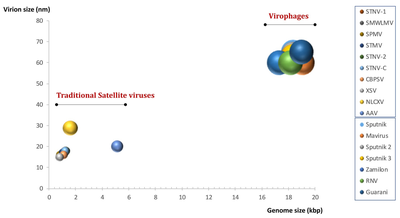

References
- Mougari, S., Sahmi-Bounsiar, D., Levasseur, A., Colson, P. and La Scola, B. (2019) "Virophages of Giant Viruses: An Update at Eleven". Viruses, 11(8): 733. doi:10.3390/v11080733.

- Duponchel, S; Fischer, MG (March 2019). "Viva lavidaviruses! Five features of virophages that parasitize giant DNA viruses". PLOS Pathogens. 15 (3): e1007592. doi:10.1371/journal.ppat.1007592. PMC 6428243. PMID 30897185.
- Fischer MG, Suttle CA (April 2011). "A virophage at the origin of large DNA transposons". Science. 332 (6026): 231–4. Bibcode:2011Sci...332..231F. doi:10.1126/science.1199412. PMID 21385722.
- Fischer MG, Hackl (December 2016). "Host genome integration and giant virus-induced reactivation of the virophage mavirus". Nature. 540 (7632): 288–91. Bibcode:2016Natur.540..288F. doi:10.1038/nature20593. PMID 27929021.
- Katzourakis, Aris; Aswad, Amr (2014). "The origins of giant viruses, virophages and their relatives in host genomes". BMC Biology. 12: 2–3. doi:10.1186/s12915-014-0051-y. PMC 4096385. PMID 25184667.
- Krupovic, Mart; Kuhn, Jens; Fischer, Metthias (Fall 2015). "A classification system for virophages and satellite viruses" (PDF). Archives of Virology. 161 (1): 233–247. doi:10.1007/s00705-015-2622-9. PMID 26446887 – via Springer.
- Roux, Simon; Chan, Leong-Keat; Egan, Rob; Malmstrom, Rex R.; McMahon, Katherine D.; Sullivan, Matthew B. (2017-10-11). "Ecogenomics of virophages and their giant virus hosts assessed through time series metagenomics". Nature Communications. 8 (1): 858. Bibcode:2017NatCo...8..858R. doi:10.1038/s41467-017-01086-2. ISSN 2041-1723. PMC 5636890. PMID 29021524.
- Paez-Espino, David; Zhou, Jinglie; Roux, Simon; Nayfach, Stephen; Pavlopoulos, Georgios A.; Schulz, Frederik; McMahon, Katherine D.; Walsh, David; Woyke, Tanja; Ivanova, Natalia N.; Eloe-Fadrosh, Emiley A.; Tringe, Susannah G.; Kyrpides, Nikos C. (2019-12-10). "Diversity, evolution, and classification of virophages uncovered through global metagenomics". Microbiome. 7 (1): 157. doi:10.1186/s40168-019-0768-5. PMC 6905037. PMID 31823797.
- Born, D; Reuter, L; Mersdorf, U; Mueller, M; Fischer, MG; Meinhart, A; Reinstein, J (10 July 2018). "Capsid protein structure, self-assembly, and processing reveal morphogenesis of the marine virophage mavirus". Proceedings of the National Academy of Sciences of the United States of America. 115 (28): 7332–7337. doi:10.1073/pnas.1805376115. PMC 6048507. PMID 29941605.
- Koonin EV, Dolja VV, Krupovic M, Varsani A, Wolf YI, Yutin N, Zerbini M, Kuhn JH (October 2019). "Create a megataxonomic framework, filling all principal taxonomic ranks, for DNA viruses encoding vertical jelly roll-type major capsid proteins". ICTV Proposal (Taxoprop): 2019.003G. doi:10.13140/RG.2.2.14886.47684.
- Bäckström D, Yutin N, Jørgensen SL, Dharamshi J, Homa F, Zaremba-Niedwiedzka K, Spang A, Wolf YI, Koonin EV, Ettema TJ (2019). "Virus genomes from deep sea sediments expand the ocean megavirome and support independent origins of viral gigantism". mBio. 10 (2): e02497-18. doi:10.1128/mBio.02497-18. PMC 6401483. PMID 30837339.PDF
- Duponchel, S. and Fischer, M.G. (2019) "Viva lavidaviruses! Five features of virophages that parasitize giant DNA viruses". PLoS pathogens, 15(3). doi:10.1371/journal.ppat.1007592.


